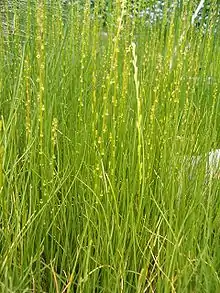Triglochin
Triglochin is a plant genus in the family Juncaginaceae described by Carl Linnaeus in 1753.[3][4] It is very nearly cosmopolitan in distribution, with species on every continent except Antarctica. North America has four accepted species, two of which can also be found in Europe: Triglochin palustris (marsh arrowgrass) and Triglochin maritima (sea arrowgrass).[5][6] Australia has many more.[1][7]
| Arrowgrass | |
|---|---|
 | |
| Triglochium palustris | |
 | |
| Triglochin calcitrapa | |
| Scientific classification | |
| Kingdom: | Plantae |
| Clade: | Tracheophytes |
| Clade: | Angiosperms |
| Clade: | Monocots |
| Order: | Alismatales |
| Family: | Juncaginaceae |
| Genus: | Triglochin L. |
| Synonyms[1] | |
| |
The most widely used common name for the genus is arrowgrass,[8] although these plants are not really grasses. Many of the common names for species make use of the term "arrowgrass", although there are exceptions: T. procera, for example, is commonly known as water ribbons.
Arrowgrasses are used as food plants by the larvae of some Lepidoptera species including the grey chi moth.
- Species[1]
- Triglochin barrelieri – Mediterranean
- Triglochin buchenaui – Cape Province
- Triglochin bulbosa – Cape Province
- Triglochin calcitrapa – Western Australia
- Triglochin centrocarpa – Australia
- Triglochin compacta – Cape Province
- Triglochin elongata – Cape Province, KwaZulu-Natal
- Triglochin gaspensis – E Canada (Nfl NB PEI NS Qbc), Maine
- Triglochin hexagona – Australia
- Triglochin isingiana – Australia
- Triglochin laxiflora – Mediterranean
- Triglochin longicarpa – Western Australia
- Triglochin maritima – Europe, Asia, North America, Algeria, Tunisia, Chile, Argentina
- Triglochin mexicana – C + S Mexico
- Triglochin milnei – from Tanzania to Angola + KwaZulu-Natal
- Triglochin minutissima – Australia
- Triglochin mucronata – Australia
- Triglochin muelleri – Australia
- Triglochin palustris – Europe, Asia, North America, Algeria, Morocco, Chile, Argentina
- Triglochin protuberans – Western Australia
- Triglochin scilloides – W Canada (BC Alb Sas), W United States (WA OR CA NV MT), Mexico, South America
- Triglochin stowardii – Western Australia
- Triglochin striata – Australia, New Zealand, Africa, United States, Bahamas, Cuba, South America
- Triglochin trichophora – Australia
- Triglochin turrifera – Australia
- formerly included
now in other genera: Bulbine, Cycnogeton and Tetroncium
- Triglochin alcockiae – Cycnogeton alcockiae – Australia
- Triglochin dubia – Cycnogeton dubium – Australia, New Guinea
- Triglochin huegelii – Cycnogeton huegelii – Western Australia
- Triglochin linearis – Cycnogeton lineare – Western Australia
- Triglochin magellanica – Tetroncium magellanicum – Tierra del Fuego, Falkland Is, Gough I
- Triglochin maundii – Maundia triglochinoides – Australia
- Triglochin microtuberosa – Cycnogeton microtuberosum – Australia
- Triglochin multifructa – Cycnogeton multifructum – Australia
- Triglochin procera – Cycnogeton procerum – Australia
- Triglochin pterocarpa – Cycnogeton dubium – Australia, New Guinea
- Triglochin racemosa – Bulbine semibarbata – Australia
- Triglochin reflexa – Tetroncium magellanicum – Tierra del Fuego, Falkland Is, Gough I
- Triglochin rheophila – Cycnogeton rheophilum – Australia
- Triglochin triglochinoides – Maundia triglochinoides – Australia
References
- Kew World Checklist of Selected Plant Families
- Tropicos search for Tristemon
- Linnaeus, Carl von. 1753. Species Plantarum 1: 338-33* in Latin
- Tropicos, Triglochin L.
- Flora of North America Vol. 22 Arrow-grass, troscart Triglochin Linnaeus
- Altervista Flora Italiana, genere Triglochin includes photos plus European distribution maps
- Flora of China Vol. 23 Page 105 水麦冬属 shui mai dong shu Triglochin Linnaeus
- "Triglochin". Natural Resources Conservation Service PLANTS Database. USDA. Retrieved 15 December 2015.
External links
- Triglochin in the Flora of North America
- USDA: Triglochin concinna [in the Flora of North America this is treated as a synonym of Triglochin maritima]
